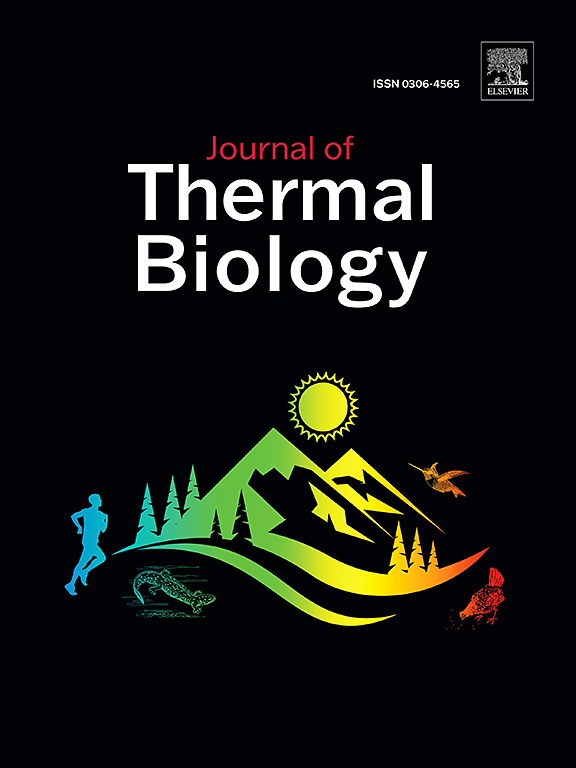Validating thermal refuge-seeking behaviour in zebrafish (Danio rerio) during acute thermal challenge
IF 2.9
2区 生物学
Q2 BIOLOGY
引用次数: 0
Abstract
Ectotherms, such as fish, are highly dependent on the stability of their environment to regulate body temperature, performance, and metabolism. Increasing temperatures cause behavioural changes in fish which can be observed and used as indices for determining upper thermal limits. The thermal agitation temperature (Tag) is a recent, and ecologically significant, sublethal index for the upper thermal limit. Previous studies have described thermal agitation as the endpoint, prior to the critical thermal maximum (CTmax), where fish start exhibiting apparent refuge-seeking and thermal avoidance behaviour. It is an assumption that fish are seeking thermal refuge at Tag, but evidence for this is lacking. Therefore, this study aimed to validate this assumption by using zebrafish (Danio rerio) and providing them with thermal refuge while increasing their environment's temperature past Tag. The behavioural responses of D. rerio were observed and their spatial movements were tracked using the animal-tracking software, AnimalTA. The analysis from this study indicated that refuge is sought out prior to Tag and distance between shoal members increases after Tag, indicating D. rerio may trade-off the protective value of a shoal to search for thermal refuge. Our study demonstrates that with refuge available, D. rerio can surpass Tag until refuge itself exceeds Tag, validating that agitation is refuge-seeking behaviour, but a mechanism of last resort. This insight improves our understanding of fish responses to thermal stress and emphasizes the value of using Tag as a sublethal metric alongside CTmax in thermal tolerance studies, with potential applications in ecology and conservation contexts.
验证斑马鱼(Danio rerio)在急性热挑战期间寻求热避难所的行为。
变温动物,如鱼类,高度依赖于环境的稳定性来调节体温、表现和新陈代谢。温度升高会引起鱼类的行为变化,这些变化可以被观察到,并用作确定温度上限的指标。热搅拌温度(Tag)是一个最近的、具有生态意义的亚致死热上限指数。先前的研究将热搅动描述为临界热最大值(CTmax)之前的终点,此时鱼类开始表现出明显的寻求庇护和热回避行为。这是一种假设,鱼类在塔格寻找热避难所,但缺乏证据。因此,本研究旨在通过使用斑马鱼(Danio rerio)为其提供热避难所,同时将其环境温度提高到超过Tag来验证这一假设。利用动物追踪软件AnimalTA对大鼠的行为反应进行了观察,并对其空间运动进行了跟踪。本研究的分析表明,在标记前寻找避难所,标记后鱼群成员之间的距离增加,表明D. rerio可能会权衡鱼群的保护价值来寻找热避难所。我们的研究表明,有了避难所,D. rerio可以超过Tag,直到避难所本身超过Tag,验证了躁动是寻求庇护的行为,但是最后手段的机制。这一发现提高了我们对鱼类对热应激反应的理解,并强调了在热耐受性研究中使用Tag和CTmax作为亚致死指标的价值,在生态学和保护环境中具有潜在的应用价值。
本文章由计算机程序翻译,如有差异,请以英文原文为准。
求助全文
约1分钟内获得全文
求助全文
来源期刊

Journal of thermal biology
生物-动物学
CiteScore
5.30
自引率
7.40%
发文量
196
审稿时长
14.5 weeks
期刊介绍:
The Journal of Thermal Biology publishes articles that advance our knowledge on the ways and mechanisms through which temperature affects man and animals. This includes studies of their responses to these effects and on the ecological consequences. Directly relevant to this theme are:
• The mechanisms of thermal limitation, heat and cold injury, and the resistance of organisms to extremes of temperature
• The mechanisms involved in acclimation, acclimatization and evolutionary adaptation to temperature
• Mechanisms underlying the patterns of hibernation, torpor, dormancy, aestivation and diapause
• Effects of temperature on reproduction and development, growth, ageing and life-span
• Studies on modelling heat transfer between organisms and their environment
• The contributions of temperature to effects of climate change on animal species and man
• Studies of conservation biology and physiology related to temperature
• Behavioural and physiological regulation of body temperature including its pathophysiology and fever
• Medical applications of hypo- and hyperthermia
Article types:
• Original articles
• Review articles
 求助内容:
求助内容: 应助结果提醒方式:
应助结果提醒方式:


